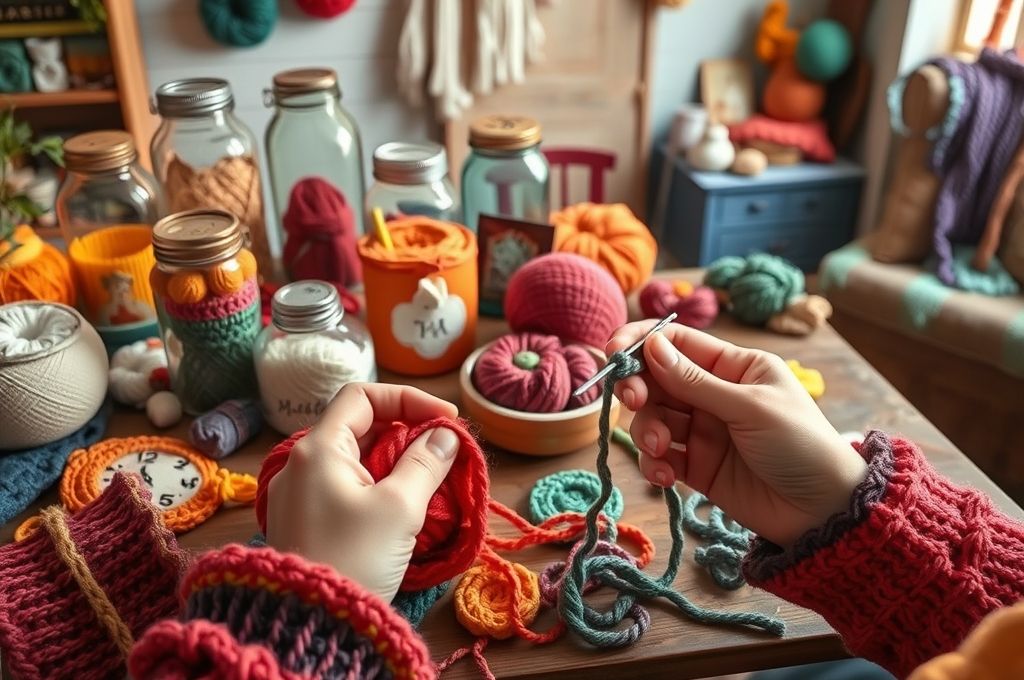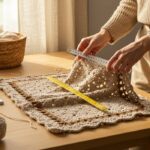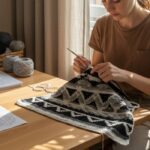Have you ever looked at an old sweater tucked away in the back of your closet and thought, “This could be so much more”? What if that faded cardigan, those worn-out jeans, or even that stained tablecloth could become something beautiful, useful, and uniquely yours? Welcome to the magical world of upcycling with crochet—where creativity meets sustainability, and every stitch tells a story.
In a world increasingly aware of environmental impact, upcycling has emerged as a powerful way to reduce waste and breathe new life into forgotten items. And when you add crochet into the mix? You get a craft that’s not only therapeutic and fun but also deeply transformative. Whether you’re a seasoned crocheter or just picking up a hook for the first time, this art form offers endless possibilities to turn what you already own into something fresh, functional, and full of personality.
This article will guide you through the inspiring journey of upcycling with crochet. We’ll explore why this practice matters, the essential tools and materials you need, creative project ideas, and practical tips to get started. You’ll discover how a simple yarn-over can transform an old T-shirt into a trendy tote bag, or how a few rows of single crochet can turn a worn-out sweater into a cozy pet bed. Along the way, we’ll share real-life examples, easy-to-follow ideas, and heartfelt reasons why this craft is more than just a hobby—it’s a lifestyle choice.
So grab your favorite hook, dust off that basket of forgotten fabrics, and let’s dive into the joyful, sustainable art of turning old items into new treasures—one loop at a time.
Why Upcycling with Crochet Matters More Than Ever
Let’s face it: our planet is drowning in textiles. According to the Environmental Protection Agency (EPA), Americans throw away over 17 million tons of textile waste each year. Shockingly, less than 15% of that gets recycled. The rest ends up in landfills, where synthetic fabrics can take hundreds of years to decompose, releasing harmful greenhouse gases in the process.
But here’s the good news: you can be part of the solution—and it starts with a simple hook and some imagination.
Upcycling, the process of transforming old or discarded materials into something of higher quality or value, is one of the most effective ways to fight fast fashion and reduce environmental harm. And crochet? It’s the perfect partner in this mission. Unlike machine-made products, hand-crocheted items are made with care, intention, and often, with materials that would otherwise be thrown away.
Crochet allows you to repair, embellish, or completely reinvent clothing and household items. A hole in a sweater isn’t a flaw—it’s an invitation to add a floral patch. A frayed hem on a pair of jeans? That’s just space for a colorful crocheted trim. With every project, you’re not just making something beautiful—you’re making a statement: I value what I have. I refuse to waste.
Beyond the environmental benefits, upcycling with crochet also nurtures mindfulness and creativity. It slows us down in a world that’s always rushing. Instead of buying new, we pause, reflect, and reimagine. This shift in mindset—from consumer to creator—is where real change begins.
And let’s not forget the personal rewards. There’s something deeply satisfying about wearing or using something you’ve handmade. It carries your energy, your story, your touch. In a world of mass-produced goods, that’s priceless.
So, why does this matter? Because every crocheted patch, every upcycled tote, every reinvented blanket is a small act of resistance against waste—and a big step toward a more thoughtful, creative life.
Getting Started: Tools, Materials, and Mindset
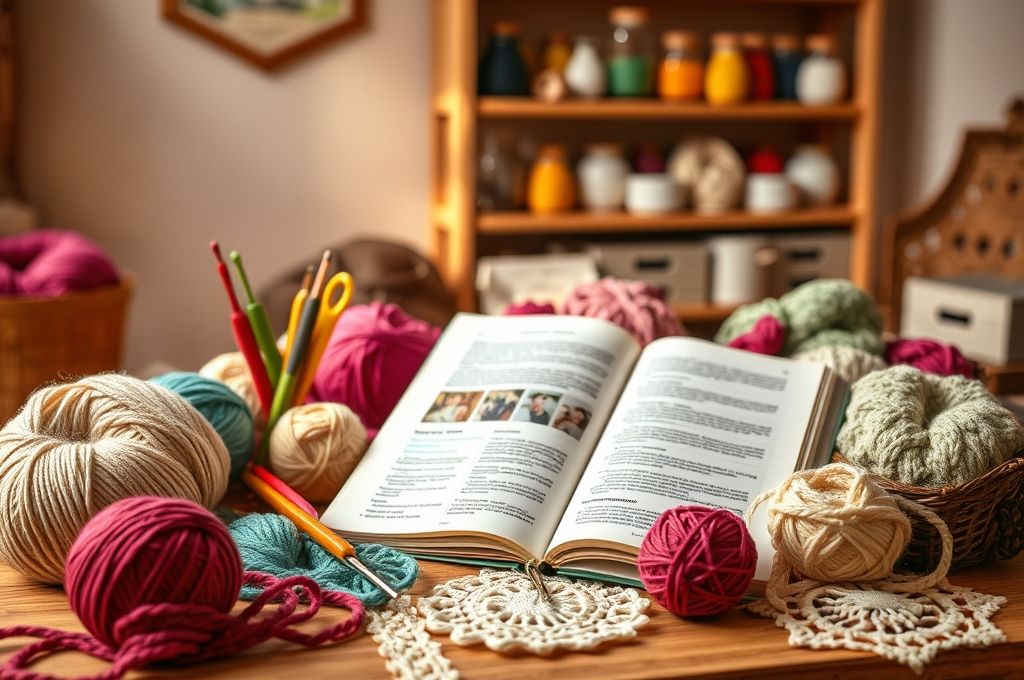
Before you dive into your first upcycling project, let’s talk about what you’ll need—and what kind of mindset will help you succeed.
The Basics: Tools You’ll Need
You don’t need a lot to get started. In fact, most of what you need might already be in your craft drawer:
- Crochet hooks (sizes vary depending on your yarn, but a size H/5.0mm or I/5.5mm is great for beginners)
- Yarn (but here’s the twist: you can make your own yarn from old clothes!)
- Scissors
- Tapestry needle (for weaving in ends)
- Stitch markers (optional but helpful)
- Measuring tape
That’s it. No fancy machines, no expensive kits. Just simple tools that empower big creativity.
The Magic of “Yarn Bombing” Your Closet
One of the most sustainable (and fun!) aspects of upcycling with crochet is creating your own yarn. Old T-shirts, sweaters, sheets, and even denim can be cut into strips and turned into t-shirt yarn or rag yarn. This not only saves money but also gives new purpose to textiles that might otherwise be trashed.
Here’s how to make t-shirt yarn:
- Lay a clean T-shirt flat.
- Cut off the hem and sleeves.
- Cut horizontally into 1-inch strips, stopping about an inch from the edge.
- Continue cutting in a spiral, and voilà—continuous yarn!
This stretchy, durable material is perfect for bags, rugs, and home decor.
The Right Mindset: Imperfection is Beautiful
One of the biggest hurdles for new crafters is the fear of making mistakes. But in upcycling, imperfection is part of the charm. A slightly uneven stitch? That’s character. A color mismatch? That’s creativity. The beauty of handmade items lies in their uniqueness.
Instead of aiming for perfection, aim for progress, play, and purpose. Let your projects evolve. Let them surprise you. And most importantly, let them be yours.
Remember: every expert crocheter was once a beginner holding a hook for the first time. You’ve got this.
Creative Ideas: 5 Easy Upcycling Projects to Try Today
Ready to turn trash into treasure? Here are five beginner-friendly projects that combine crochet with upcycled materials—each one practical, beautiful, and perfect for building confidence.
1. T-Shirt Tote Bag with Crocheted Handles
Turn an old graphic tee into a stylish, eco-friendly shopping bag.
- Cut the front and back panels from the shirt.
- Sew or crochet the sides and bottom.
- Use t-shirt yarn to crochet sturdy handles.
- Add a crocheted border for flair.
Why it works: No sewing machine? No problem. You can crochet the entire bag or just the details. Plus, you get to keep that cool band logo or vintage design!
2. Sweater Pillow or Pet Bed
That holey winter sweater? It’s not garbage—it’s a future cozy pillow.
- Cut the front and back of the sweater to the same size.
- Crochet a border around the edges to prevent fraying.
- Sew three sides closed, stuff with old pillow filling or fabric scraps, then hand-stitch the last side.
- Optional: crochet a floral or geometric patch over the hole.
Bonus: Make a smaller version for your cat or dog. They’ll love the soft wool and your love stitched right in.
3. Denim Coasters with Crocheted Edging
Old jeans are gold in the upcycling world. Turn them into durable coasters.
- Cut denim into 4-inch squares.
- Use cotton yarn to single crochet around the edge.
- Add a second round in a contrasting color.
These are great for gifts or adding rustic charm to your coffee table.
4. Scarf from Fabric Scraps
Got leftover pieces from other projects? Chain them together.
- Cut fabric into 1-inch strips.
- Knot strips together to form a long strand.
- Crochet using a simple double crochet stitch.
The result? A chunky, textured scarf that’s as unique as you are.
5. Table Runner from Old Linens
Vintage tablecloths or sheets with stains? Cut out the clean parts.
- Piece together fabric strips.
- Crochet a lace edging along both sides.
- Use a vintage-inspired stitch like shell or pineapple for elegance.
This project blends nostalgia with modern craft—perfect for holiday dinners or farmhouse decor.
Each of these projects proves that you don’t need new materials to create something new. You just need vision, a hook, and the courage to begin.
The Emotional and Environmental Impact of Upcycled Crochet
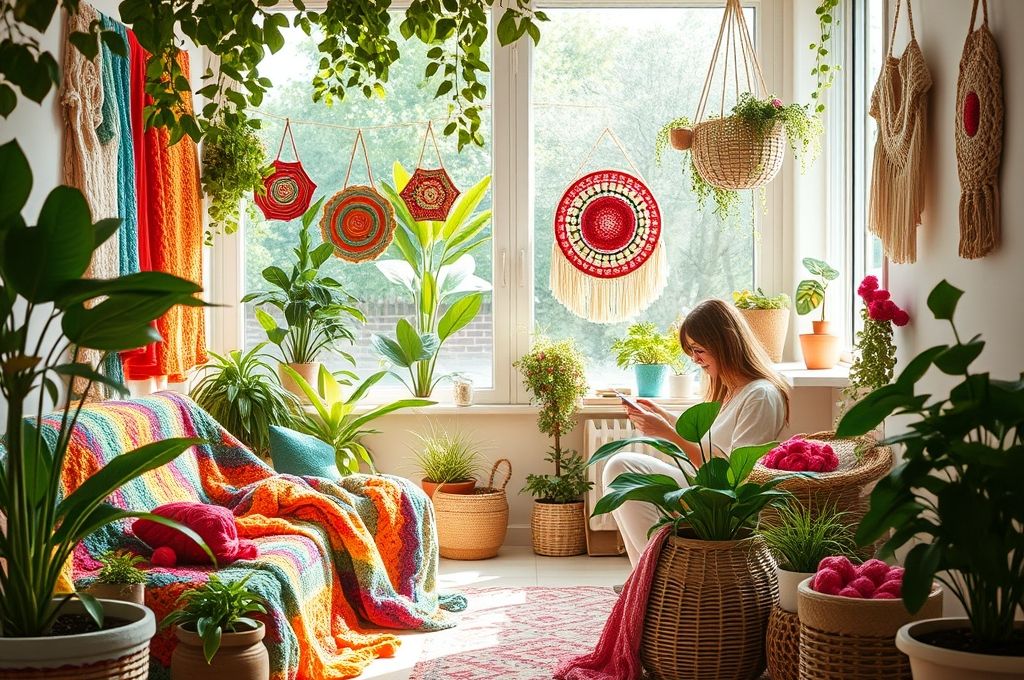
It’s easy to focus on the tangible results of upcycling—new bags, pillows, decor—but the deeper impact runs much further.
Healing Through Making
Many people turn to crochet during tough times. The rhythmic motion of the hook, the focus on each stitch—it’s a form of moving meditation. When you combine that with upcycling, you’re not just crafting; you’re healing.
Imagine turning your late grandmother’s sweater into a baby blanket for your child. That’s not just fabric—it’s love passed down. Or transforming a shirt from a past relationship into a wall hanging. That’s closure, stitched with care.
Art therapists often use textile crafts to help people process grief, anxiety, and trauma. There’s something profoundly grounding about working with your hands, especially when you’re giving new life to something meaningful.
A Stand Against Fast Fashion
The fashion industry is one of the largest polluters in the world. Fast fashion brands produce cheap clothing at an alarming rate, encouraging overconsumption and disposability. But when you upcycle, you reject that model.
Every upcycled crochet project says: I choose quality over quantity. I choose creativity over convenience. I choose to care.
And the ripple effect is real. When friends see your crocheted tote made from an old band tee, they ask, “Where’d you get that?” That’s your chance to share the story—and maybe inspire someone else to try upcycling.
Small Actions, Big Change
You might think, “I’m just one person. How much difference can I really make?” But consider this: if just 1 million people upcycled one clothing item per year, that’s 1 million fewer garments in landfills. Multiply that by creativity, community, and shared inspiration, and you’ve got a movement.
Upcycling with crochet isn’t about saving the world in one stitch. It’s about making choices—day after day—that add up to something beautiful.
Tips for Success: How to Make Your Upcycling Projects Shine
Starting is the hardest part—but once you’re in motion, these tips will help you stay inspired and avoid common pitfalls.
1. Start Small
Don’t try to turn your entire closet into a crochet masterpiece on day one. Begin with one item: a T-shirt, a pair of socks, a dish towel. Finish it. Wear it. Enjoy it. Momentum builds from completion, not ambition.
2. Match Yarn to Purpose
Not all yarns are created equal. For items that need durability (like bags or rugs), use t-shirt yarn or cotton. For softness (like scarves or baby items), go for wool or acrylic blends. When using fabric strips, consider stretch and weight.
3. Use the Right Stitch
Some stitches are better for edging, others for texture. For beginners:
- Single crochet = tight, sturdy, great for edges
- Double crochet = faster, looser, good for blankets
- Spike stitch or puff stitch = adds texture and flair
Practice on scraps before committing to your main project.
4. Embrace Visible Mending
Don’t hide repairs—celebrate them. Japanese boro and sashiko traditions embrace mended clothing as art. Try crocheting a bright flower over a hole, or a geometric pattern on a worn elbow. It’s not about hiding flaws—it’s about honoring the journey.
5. Document and Share
Take photos of your projects. Share them online with hashtags like #upcycledcrochet or #slowfashion. You’ll not only build confidence but also inspire others. Who knows? You might start a local crafting group or even a small Etsy shop.
6. Store and Organize Smartly
Keep upcycled materials in labeled bins: “Cotton Shirts,” “Wool Sweaters,” “Denim.” Store yarn in clear containers. A little organization goes a long way in keeping your creativity flowing.
Remember: every expert was once a beginner. The only “bad” project is the one you never start.
From Hobby to Habit: Building a Sustainable Crafting Lifestyle
Upcycling with crochet doesn’t have to be a weekend project—it can become a way of life.
Create a “Re-Craft” Routine
Set aside 30 minutes a week to go through your donation pile. Ask: Can this be upcycled? Pull out items with interesting textures, colors, or sentimental value. Keep a “crochet bin” ready with hooks, needles, and scissors.
Host a Upcycling Party
Invite friends over with their old clothes and your crochet supplies. Share ideas, teach each other stitches, and turn trash into treasure together. It’s social, sustainable, and soul-nourishing.
Teach the Next Generation
Show your kids, nieces, or students how to make t-shirt yarn or crochet a simple patch. These skills aren’t just practical—they’re empowering. You’re teaching them to value resources, think creatively, and express themselves.
Think Beyond Clothing
Upcycling isn’t just for fabrics. Try:
- Crocheting plant holders from old netting or plastic bags (yes, plastic can be upcycled too!)
- Turning curtains into tote bags
- Using quilt scraps for patchwork coasters
The possibilities are limited only by imagination.
And as you build this habit, you’ll notice a shift. You’ll start seeing potential everywhere. That stained dress? Future rug. That torn towel? Next project. You’ll become a creative detective, always on the lookout for hidden gems in the ordinary.
The Bigger Picture: How Upcycled Crochet Fits into a Sustainable Future
It’s easy to see upcycling as a niche craft, but its implications are global.
As climate change accelerates, we need everyday solutions that individuals can adopt. Upcycling with crochet is one of them. It reduces waste, conserves resources, and fosters a culture of care over consumption.
Communities around the world are already embracing this movement:
- In Ghana, artisans turn plastic bags into crocheted baskets sold internationally.
- In the UK, “mending cafes” teach people to repair clothes with crochet and embroidery.
- In the U.S., schools are incorporating textile upcycling into art curricula.
These aren’t just feel-good stories—they’re models for a circular economy, where materials are reused, not discarded.
And here’s the beautiful part: you don’t need to be an activist to make a difference. You just need to pick up a hook and start.
Every time you choose to mend instead of toss, to create instead of buy, you’re voting for a more sustainable world. You’re saying, I believe in second chances—for clothes, for the planet, and for myself.
Crochet is more than a craft. It’s a quiet revolution, one loop at a time.
Conclusion: Your Hook, Your Power, Your Planet
We’ve come a long way—from understanding the environmental crisis of textile waste to discovering how a simple crochet hook can be a tool of transformation. We’ve explored practical projects, emotional rewards, and the broader impact of choosing to upcycle.
But now, the ball is in your court.
You don’t need a big budget, a fancy studio, or years of experience. You just need one item you were about to throw away and the willingness to see it differently.
Start small. Try one project. Share it. Celebrate it.
Because when you upcycle with crochet, you’re not just making a bag or a blanket—you’re making a statement. You’re saying that beauty doesn’t have to be bought. That creativity can grow from scraps. That care, in every sense of the word, matters.
So what will you turn into a treasure today?
Maybe it’s that sweater your dog chewed. Maybe it’s your child’s outgrown pajamas. Or maybe it’s just a pile of old T-shirts waiting for a second life.
Whatever it is, pick it up. Grab your hook. And start stitching.
And when you’re done, we’d love to hear from you: What’s the first item you’re going to upcycle? Share your story in the comments, tag us on social media, or simply smile, knowing you’ve made a difference—one beautiful, handmade stitch at a time.

Daniele Ferreira is passionate about the world of crochet, dedicating her time to exploring techniques, creating unique pieces, and sharing her knowledge with beginners and aficionados alike. With attention to detail and creativity, she transforms yarn into true works of art, inspiring others to discover the beauty and joy of this manual art.

